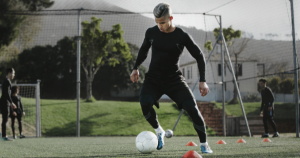Flexibility plays a crucial role in football, enhancing performance and significantly reducing injury risks.
Whether you’re an aspiring player or a seasoned pro, understanding the importance of flexibility can give you a competitive edge on the field.
With over 15 years of experience in player development, PlayerScout has helped millions of players improve their fitness, mindset, and nutrition.
This post will dive deep into how flexibility aids football performance and offer tailored stretching routines to keep you at the top of your game.
Contents
The Science Behind Flexibility and Football Performance
How Flexibility Improves Performance
Flexibility is key for footballers. It helps them move freely, improving their agility and speed. When you’re flexible, you can make those sharp turns and quick sprints more efficiently. It also allows for better control over your body, making dribbling and shooting more precise.
Improved flexibility means your muscles can stretch and contract more effectively. This leads to better performance in high-intensity situations. Flexibility also helps with balance and coordination, crucial for avoiding tackles and maintaining possession.
Scientific Studies on Flexibility in Football
Several studies highlight the importance of flexibility in football. Research shows that flexible players are less prone to injuries. A study published in the Journal of Sports Sciences found that flexibility training significantly reduces the risk of muscle strains.
Another study in the American Journal of Sports Medicine reported that teams incorporating regular stretching routines had fewer injuries throughout the season . This means more playing time and less time on the bench.
Flexibility also enhances muscle recovery. According to Sports Medicine, players who stretch regularly experience less muscle soreness after games and training sessions . This quicker recovery allows for more consistent performance and training. Flexibility and recovery study (NCBI) .
FOR PLAYERS
FREE Scouting Secrets 2024
Everything you need to know, to gain exposure, build your profile as a player, and make yourself #UNDROPPABLE.
FOR PARENTS
FREE Guide To Supporting Young Footballers 2024
This FREE guide helps you improve your childs performance on the pitch, enjoyment of the game, and strengthens your bond through football.
Types of Stretching Exercises for Footballers
Dynamic Stretching
Dynamic stretching is key before a game. It helps warm up your muscles and get your body ready for action. Unlike static stretching, dynamic stretches involve movement and increase your range of motion.
Benefits of Dynamic Stretching
- Improves flexibility: Helps increase the range of motion.
- Boosts performance: Prepares muscles for the game, making them more responsive.
- Reduces injury risk: Warms up muscles, tendons, and joints, lowering the chance of injuries.
Dynamic Stretching Exercises
Leg Swings
- Stand on one leg.
- Swing the other leg forward and backward.
- Repeat 10-15 times on each leg.
High Knees
- Jog in place, bringing your knees up to hip level.
- Keep a fast pace for 30-60 seconds.
Butt Kicks
- Jog in place, kicking your heels up to touch your buttocks.
- Continue for 30-60 seconds.
Walking Lunges
- Step forward with one leg.
- Lower your hips until both knees are bent at a 90-degree angle.
- Step forward with the other leg and repeat.
- Perform 10-15 reps on each side.
Arm Circles
- Extend your arms out to the sides.
- Make small circles with your arms.
- Gradually increase the size of the circles.
- Do 20-30 seconds in each direction.

Static Stretching
Static stretching is best after a game or workout. It helps cool down your muscles and improves flexibility over time. Unlike dynamic stretching, you hold these stretches without movement.
Benefits of Static Stretching
- Enhances flexibility: Lengthens muscles and improves overall flexibility.
- Aids recovery: Helps relax muscles and reduce soreness after exercise.
- Prevents injuries: Regular stretching can help prevent long-term injuries.
Static Stretching Exercises
Hamstring Stretch
- Sit on the ground with one leg extended.
- Reach toward your toes.
- Hold for 20-30 seconds and switch legs.
Quad Stretch
- Stand on one leg.
- Pull your other foot towards your buttocks.
- Hold for 20-30 seconds and switch legs.
Calf Stretch
- Stand facing a wall.
- Place one foot forward and one foot back.
- Push against the wall and keep the back leg straight.
- Hold for 20-30 seconds and switch legs.
Shoulder Stretch
- Bring one arm across your chest.
- Use the other arm to hold it in place.
- Hold for 20-30 seconds and switch arms.
Hip Flexor Stretch
- Kneel on one knee.
- Push your hips forward.
- Hold for 20-30 seconds and switch legs.
These stretches help keep your body flexible and ready for the demands of football. Make them a regular part of your training routine to improve performance and reduce the risk of injuries.
READY TO TAKE THE CHALLENGE?
30 Days To Fast-Track Your Fitness, Speed, Strength & Performance

Flexibility Training Routines
Warm-up Exercises for Footballers
Warming up is crucial. It prepares your body for the intense activity ahead. Here’s a simple yet effective warm-up routine:
- Light Jogging: Start with 5-10 minutes of light jogging. This gets your blood flowing and muscles ready.
- High Knees: Do 2-3 sets of 20 seconds. Lift your knees high, alternating legs quickly.
- Butt Kicks: Do 2-3 sets of 20 seconds. Kick your heels towards your glutes while jogging in place.
- Arm Circles: Perform forward and backward arm circles for 30 seconds each. This loosens your shoulder joints.
- Leg Swings: Swing each leg forward and backward for 30 seconds. Then, swing each leg side to side for another 30 seconds.
Dynamic Stretching Routine for Footballers
Dynamic stretching involves moving parts of your body and gradually increasing reach, speed of movement, or both. Here’s a routine to improve flexibility and reduce injury risk:
- Leg Cradles: Do 10 reps per leg. Stand tall, lift one knee, and pull it towards your opposite shoulder.
- Walking Lunges: Do 2 sets of 10 reps. Step forward into a lunge, then bring your back leg forward to stand up straight and repeat with the other leg.
- Frankenstein Walks: Do 2 sets of 10 reps per leg. Keep your legs straight and kick them up to your opposite hand as you walk.
- Hip Circles: Do 2 sets of 10 reps per direction. Stand on one leg and make large circles with your other leg.
- Torso Twists: Perform 2 sets of 15 reps. Twist your upper body side to side, keeping your hips facing forward.

Post-Game Static Stretching Routine
Static stretching helps to cool down your muscles and improve flexibility over time. Hold each stretch for 20-30 seconds:
- Hamstring Stretch: Sit on the ground with one leg extended. Reach for your toes, keeping your back straight.
- Quadriceps Stretch: Stand on one leg, pull your opposite foot towards your buttocks. Keep your knees together.
- Calf Stretch: Stand facing a wall. Place one foot behind you and press your heel down.
- Groin Stretch: Sit with your feet together, knees bent out to the sides. Press your knees down gently.
- Shoulder Stretch: Cross one arm over your chest and use your other arm to press it in.
Tips for Integrating Flexibility Training into Regular Practice
Integrating flexibility training into your routine doesn’t have to be complicated. Here are some tips:
- Consistency is Key: Stretch daily, even on non-training days.
- Incorporate into Warm-ups and Cool-downs: Make dynamic stretches part of your warm-up and static stretches part of your cool-down.
- Use Rest Days: Use rest days for longer, more relaxed stretching sessions.
- Stay Hydrated: Hydration helps maintain muscle elasticity.
- Listen to Your Body: Never stretch to the point of pain. Mild discomfort is normal, but pain indicates you’ve gone too far.
- Use Proper Technique: Ensure you’re performing each stretch correctly to avoid injury and maximize benefits.
By following these routines and tips, you’ll enhance your flexibility, improve your performance, and reduce the risk of injury on the field.
OUR SIGNATURE PROGRAM
Become A Fitter, Faster, Stronger, And More Powerful Player Over The Next 12 Months

Advanced Flexibility Techniques for Footballers
Sample Flexibility Training Routine
Flexibility is key for footballers. It helps with agility, injury prevention, and overall performance. Here’s a sample routine:
Warm-Up:
- Jogging: 5 minutes
- Dynamic Stretching: 10 minutes (leg swings, arm circles, high knees)
Main Routine:
Hamstring Stretch:
- Hold for 30 seconds on each leg
Quadriceps Stretch:
- Hold for 30 seconds on each leg
Calf Stretch:
- Hold for 30 seconds on each leg
Hip Flexor Stretch:
- Hold for 30 seconds on each side
Groin Stretch:
- Hold for 30 seconds
Cool Down:
- Walking: 5 minutes
- Static Stretching: 10 minutes (repeat main routine)
Yoga and Pilates For Footballers
Yoga: Yoga enhances flexibility, balance, and mental focus. Here are a few poses perfect for footballers:
- Downward Dog: Strengthens the hamstrings and calves.
- Pigeon Pose: Opens the hips and stretches the glutes.
- Cobra Pose: Stretches the back and improves spinal flexibility.
Pilates: Pilates strengthens core muscles, improving stability and coordination:
- The Hundred: Great for core strength.
- Single Leg Stretch: Works on core stability and leg strength.
- Spine Stretch Forward: Improves flexibility in the spine and hamstrings.
Benefits of Enhancing Flexibility
Flexibility training offers numerous benefits for footballers:
- Improved Performance: Enhanced range of motion allows for better agility and quick direction changes.
- Injury Prevention: Reduces the risk of muscle strains and ligament injuries.
- Faster Recovery: Helps muscles recover faster post-training.
- Better Balance: Improves overall balance and coordination on the field.
Beginner-Friendly Yoga Routine
Here’s a simple yoga routine tailored for footballers new to yoga:
Mountain Pose:
- Stand tall, hold for 1 minute
Forward Bend:
- Bend forward, hold for 30 seconds
Downward Dog:
- Hold for 1 minute
Warrior I:
- Hold for 30 seconds on each side
Child’s Pose:
- Hold for 1 minute

Common Mistakes and How to Avoid Them
When training for flexibility in football, players often make several mistakes that can hinder their performance and increase the risk of injury. Here, we’ll identify these common pitfalls and provide tips to avoid them.
Over-Stretching
What is Over-Stretching? Over-stretching occurs when players push their muscles beyond their natural range of motion, which can lead to strains and tears.
How to Avoid Over-Stretching:
- Warm-Up Properly: Always begin with a light warm-up to increase blood flow to the muscles.
- Know Your Limits: Stretch until you feel a gentle pull, not pain. Gradually increase flexibility over time.
- Use Dynamic Stretching: Incorporate movements that mimic the activity you’re about to perform. For football, this includes leg swings and lunges.
Incorrect Technique
What is Incorrect Technique? Using improper form during stretching exercises can lead to ineffective results and potential injuries.
How to Avoid Incorrect Technique:
- Learn Proper Form: Use resources like videos and guides to understand the correct way to perform each stretch.
- Seek Professional Guidance: Consult with a coach or physical therapist to ensure your technique is correct.
- Monitor Your Form: Regularly check your form in a mirror or ask a teammate for feedback.
Skipping Stretching Sessions
What is Skipping Stretching Sessions? Neglecting to stretch regularly can decrease flexibility and increase the risk of injury during play.
How to Avoid Skipping Stretching Sessions:
- Create a Routine: Integrate stretching into your daily training schedule.
- Set Reminders: Use phone reminders or workout apps to keep you on track.
- Make it Enjoyable: Listen to music or stretch with teammates to make the session more enjoyable.
Not Holding Stretches Long Enough
Failing to hold stretches for a sufficient amount of time reduces their effectiveness in improving flexibility.
How to Avoid Not Holding Stretches Long Enough:
- Follow Guidelines: Hold each stretch for at least 30 seconds to allow the muscles to lengthen properly.
- Use a Timer: Set a timer to ensure you hold each stretch for the recommended duration.
- Stay Focused: Concentrate on your breathing and the sensation of the stretch to maintain the position longer.
Focusing Only on Lower Body
Many footballers only stretch their lower body, neglecting the upper body muscles which are also crucial for overall flexibility and performance.
How to Avoid Focusing Only on Lower Body:
- Full-Body Routine: Incorporate stretches for the upper body, such as shoulder and arm stretches, into your routine.
- Balanced Approach: Ensure your flexibility training is well-rounded, targeting all major muscle groups.
Ignoring Muscle Imbalances
Muscle imbalances occur when one muscle group is significantly stronger or more flexible than its opposing group, leading to an increased risk of injury.
How to Avoid Ignoring Muscle Imbalances:
- Balanced Training: Include exercises that address both the dominant and weaker muscle groups.
- Regular Assessments: Perform regular flexibility assessments to identify and correct imbalances.
- Personalized Stretches: Tailor your stretching routine to target areas that need improvement.
By recognizing and addressing these common mistakes, footballers can enhance their flexibility training, reduce injury risks, and improve their performance on the field.

FAQs
Why is flexibility important for footballers?
Flexibility is important for footballers because it enhances their range of motion, allowing them to perform movements more efficiently and effectively. Improved flexibility reduces the risk of injuries by preparing muscles and joints for the demands of the game. It also contributes to better overall athletic performance, including agility and endurance.
What are the common mistakes footballers make in flexibility training?
Common mistakes footballers make in flexibility training include over-stretching, using incorrect techniques, and skipping sessions. Over-stretching can lead to muscle strains, while improper techniques reduce effectiveness and risk injury. Skipping sessions hinders progress. To avoid these, warm up properly, use correct form, and maintain a consistent routine.
How can over-stretching lead to injuries?
Over-stretching can lead to injuries by pushing muscles and ligaments beyond their natural range of motion. This can cause strains, tears, and damage to the muscle fibers. It’s important to listen to your body and stop stretching if you feel pain. Always warm up properly and stretch within comfortable limits to prevent injury.
What are the best types of stretches for football players?
The best types of stretches for football players are dynamic and static stretches. Dynamic stretches like leg swings and high knees are ideal before a game to warm up muscles and improve range of motion. Static stretches, such as hamstring and quad stretches, are best post-game to aid recovery and enhance flexibility.
How often should footballers incorporate flexibility training into their routine?
Footballers should incorporate flexibility training into their routine at least three to four times a week. Regular stretching helps maintain and improve flexibility, which is essential for optimal performance and injury prevention. Integrating dynamic stretches before workouts and static stretches post-workout ensures muscles are prepared and recover effectively.
What is the difference between static and dynamic stretching?
The difference between static and dynamic stretching lies in movement. Static stretching involves holding a stretch for a prolonged period, usually 15-30 seconds, which helps increase flexibility and relax muscles. Dynamic stretching, on the other hand, involves active movements that take your muscles through their full range of motion, preparing them for physical activity.
Can flexibility training improve performance on the field?
Yes, flexibility training can improve performance on the field. By enhancing your range of motion and muscle elasticity, flexibility training allows for smoother, more efficient movements, reducing the risk of injury. This increased agility and reduced muscle stiffness can directly translate to better performance in tasks like dribbling, shooting, and tackling.
What are the signs of improper stretching techniques?
Signs of improper stretching techniques include feeling pain instead of a gentle pull, bouncing during stretches, and holding your breath. If you experience sharp or stabbing pain, you might be over-stretching. Bouncing can cause muscle tears, and holding your breath prevents your muscles from relaxing properly. Always stretch slowly and breathe deeply to avoid these issues.
How can footballers create a balanced flexibility training program?
Footballers can create a balanced flexibility training program by combining dynamic stretches before activities and static stretches afterward. A balanced routine includes exercises targeting all major muscle groups, ensuring a full range of motion and preventing muscle imbalances. Incorporating flexibility assessments and personalizing stretches to address specific needs will also enhance effectiveness.
What are some effective warm-up stretches for footballers?
Effective warm-up stretches for footballers include dynamic stretches like leg swings, high knees, and butt kicks. These stretches prepare your muscles for the game by increasing blood flow and flexibility. Always start with a light jog to warm up before stretching. Incorporating these exercises into your routine can help prevent injuries and improve performance.

Conclusion
Flexibility is essential for footballers, boosting performance and reducing injury risks.
By incorporating dynamic and static stretching routines into your training, you can enhance your agility, speed, and muscle recovery.
Address common mistakes like over-stretching and improper techniques to maximize your flexibility training benefits.
Ready to take your training to the next level? Join our Football Fitness Accelerator – 30 Day Challenge to learn more and improve your game.















